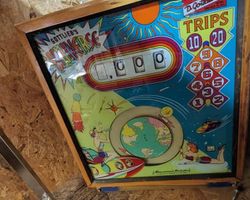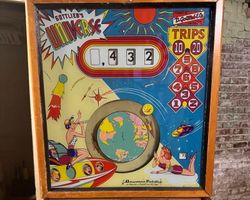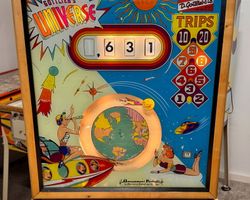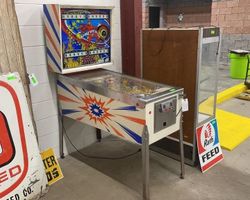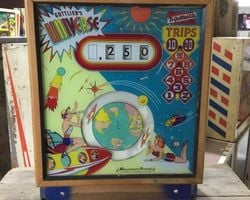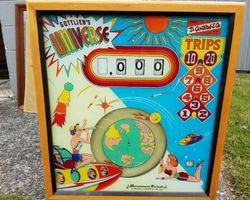Universe
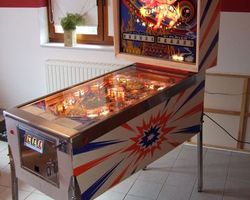
Average Prices: USD $500 to $2,100
Produced: October, 1959
Production Run: 1,150 units
Machine Type: Electro-mechanical
Players: 1
Design by: Wayne Neyens
Art by: Roy Parker
Gottlieb’s "Universe" pinball machine, released in October 1959, transported players into the nascent space age with its captivating theme and innovative features. Manufactured by D. Gottlieb & Co., a company long at the forefront of pinball machine development, "Universe" emerged during a period of intense public fascination with space exploration, directly channeling the excitement generated by early rocket launches and celestial ambitions.
The creation of "Universe" was largely orchestrated by Wayne Neyens, a prolific designer whose vision shaped many of Gottlieb's electro-mechanical (EM) machines. Neyens is credited not only with the overall design and concept but also with the intricate mechanics and the engaging backbox animation that set "Universe" apart. The machine’s striking visual identity, however, sprang from the artistic talent of Roy Parker. Parker’s artwork, particularly on the backglass and playfield, masterfully captured the cosmic theme, depicting a vibrant interstellar tableau that drew players into its orbit. With a production run of only 1,150 units, "Universe" became a relatively limited release for its time, contributing to its distinct presence in the market and its appeal to collectors in later years. A notable detail, characteristic of Gottlieb’s machines from this era, is the phrase emblazoned on the backglass: “Amusement Pinballs, as American as Baseball and Hot Dogs!” – a playful nod to the cultural integration of the game.
Signature Features and Design
"Universe" distinguishes itself with several standout features that directly enhance its gameplay and thematic immersion. Foremost among these are its four flippers, a significant departure from the standard two-flipper setup common at the time. This arrangement comprises two traditional lower flippers and two smaller, strategically positioned upper flippers located above the slingshots. This four-flipper configuration fosters unique ball control opportunities, enabling players to execute complex passes between the upper and lower sets, adding layers of strategy and skill to each game.
Another defining characteristic is the mechanical backbox animation. Central to the backglass art, this feature showcases two rocket ships perpetually circling a depiction of Earth. As specific targets are hit on the playfield, these rocket ships advance along their orbital path. Each time a rocket completes a journey to the moon, a "trip" is scored, directly linking player performance on the playfield to a dynamic visual reward in the backbox. This animation, coupled with the distinctive "clunking rotary rocket wheel" sound and the chiming bells, created an immersive auditory and visual experience that perfectly complemented the outer space theme. Roy Parker's artwork throughout the machine, from the vibrant celestial bodies on the playfield to the detailed rockets and lunar landscapes on the backglass, is consistently described as beautiful and contributes significantly to the machine's enduring visual appeal.
Playfield and Mechanics
The playfield layout of "Universe" is characterized by its relatively open design, which allows for fast-paced gameplay and emphasizes skillful flipper work. The key interactive elements are strategically placed to encourage diverse shotmaking. Three pop bumpers are positioned higher on the playfield, generating unpredictable ball deflections and awarding points. Two bullseye targets offer direct scoring opportunities, demanding precise aiming from the player. Enhancing ball movement and score accumulation are two slingshots, each flanked by one of the smaller upper flippers. A single gobble hole provides an additional challenge, adding an element of risk-reward to the game.
The design philosophy behind "Universe" leans heavily on the interaction between its four flippers. The layout encourages players to master the art of passing the ball from the lower flippers to the upper ones, setting up shots to the targets and rollovers higher on the playfield. This interplay between the flipper sets is central to achieving high scores and advancing the backbox animation. While some characterize the playfield as "wide-open," this design choice facilitates long rebounds and promotes a fluid, often acrobatic, ball flow when the machine is properly maintained. The artwork on the playfield maintains Roy Parker's cohesive cosmic theme, depicting starry nebulae and planetary bodies that ground the gameplay visually within the "Universe" concept. The lighting, typical of EM machines, highlights key scoring areas and adds to the machine's classic arcade aesthetic.
Gameplay Dynamics
The gameplay dynamics of "Universe" are built around a dual-point scoring system, offering players two distinct paths to achieve a replay. The primary scoring revolves around accumulating points through hitting targets, pop bumpers, and making various shots on the playfield. Complementing this is the "trips" mechanic, directly tied to the backbox animation. Players accumulate "advances" by hitting specific features, which in turn move the rocket ships closer to the moon. Each time a rocket reaches the moon, a "trip" is scored, contributing to a separate replay threshold. This dual objective system provides a constant engagement loop, allowing players to focus on maximizing points or strategically aiming for "trips," or a combination of both.
Unique objectives include skillfully using the four flippers to control the ball. The ability to pass the ball from the lower flippers to the upper ones is paramount for initiating shots towards the bullseye targets and other upper playfield features that contribute to "trip" advances. The open layout demands a keen understanding of ball trajectory and encourages nudging – the subtle art of influencing the ball's path by gently moving the machine – to redirect rebounds and set up crucial shots. While the game's core objectives are straightforward, mastering the four-flipper control and maximizing the "trip" count adds depth. Optimizing the machine with strong lower flipper coils is often recommended by enthusiasts, as powerful flippers are essential for the game to truly shine, allowing for direct strikes and consistent returns to the upper playfield.
Reception and Legacy
"Universe" has garnered a largely positive reception among pinball enthusiasts and collectors, primarily due to its unique blend of artistic flair and engaging gameplay mechanics. Its most lauded strengths include Roy Parker's magnificent space-themed artwork, which many consider a high point in EM pinball aesthetics. The four-flipper setup is frequently cited as a distinctive and enjoyable feature, providing a level of ball control and strategic passing opportunities not often found in machines of its era. The integrated mechanical backbox animation, with its visually rewarding "trip" scoring, is also consistently praised for adding charm and thematic depth. The dual-point scoring system, allowing replays for both accumulated points and "trips," contributes significantly to its high "fun factor." Its relatively low production numbers have also made it a sought-after collectible.
However, "Universe" is not without its specific criticisms. Some players find the playfield layout to be "wide-open," with considerable empty space, which can sometimes lead to fast drains if ball control is not maintained. A recurring point of feedback concerns the lower flippers; if they are weak or improperly tuned, gameplay can suffer considerably, making it challenging to control the ball and execute necessary shots to the upper playfield. While many appreciate its elegance, some advanced players perceive "Universe" as being "simple" compared to later, more complex pinball designs. A minor discrepancy noted by enthusiasts is that while the backglass depicts space for 20 "trips," the internal stepper unit only registers up to 19. Despite these points, "Universe" maintains a strong reputation. Its innovative four-flipper design and integrated backbox animation contributed to the evolving landscape of EM pinball, demonstrating how mechanical features could be seamlessly woven into a compelling theme. "Universe" remains a celebrated example of Gottlieb's creative prowess during the late 1950s, continuing to captivate those who encounter its cosmic allure.
Sponsored Links
 Ebay Listings
Ebay Listings
 Auction Results
Auction Results
| Cost | Location | Date |
|---|---|---|
| USD $465 |  Georgia, United States Georgia, United States |
17 August, 2025 |
| USD $2,700 |  Massachusetts, United States Massachusetts, United States |
17 April, 2025 |
| USD $1,050 |  Ohio, United States Ohio, United States |
12 September, 2024 |
| AUD $2,900 |  New South Wales, Australia New South Wales, Australia |
02 October, 2022 |
| USD $550 |  Tennessee, United States Tennessee, United States |
26 February, 2022 |
| USD $1,895 |  Maryland, United States Maryland, United States |
30 December, 2019 |
| USD $1,775 |  Washington, United States Washington, United States |
25 October, 2019 |
| USD $1,800 |  Minnesota, United States Minnesota, United States |
25 August, 2019 |
| USD $1,800 |  Minnesota, United States Minnesota, United States |
08 August, 2019 |
| USD $1,600 |  United States United States |
21 May, 2015 |


Private Policy · Search Website · Contact Us
As an eBay Partner, we may earn a commission from qualifying purchases made through links on this site, at no additional cost to you.
All trademarks and copyrighted materials remain property of their respective owners. All other content copyright 2007 - 2026 Pinpedia.

